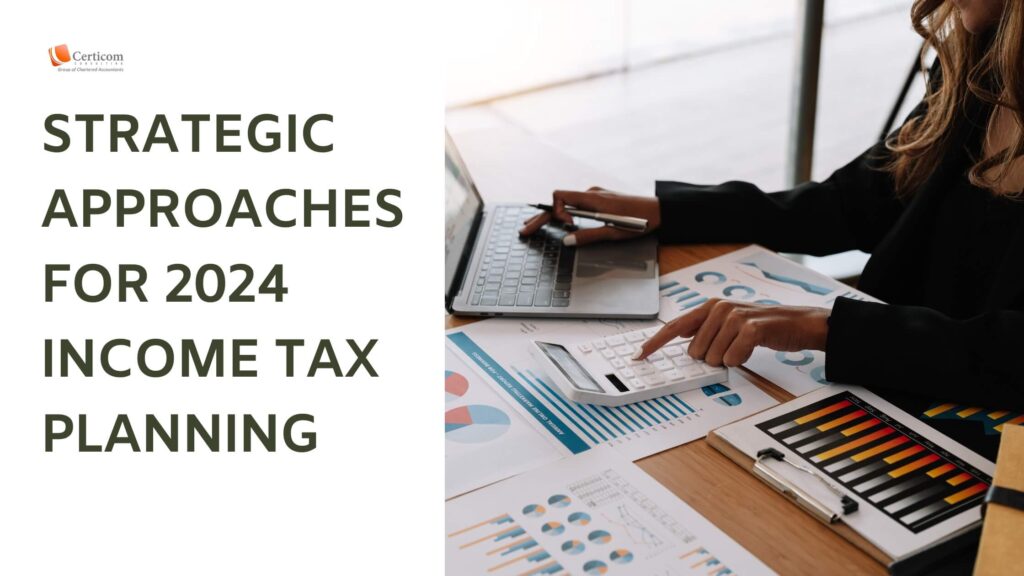Strategic Approaches, Sections, and Investment Choices for 2024 Income Tax Planning

Few people can be without resolutions as the New Year 2024 approaches, with less than a month to go. For both individuals and families, the top priorities among these are investment plans and tax planning.
Thoughtful Consideration
A year-round approach is essential to successful tax planning. The Income Tax Act’s Section 80C provides deductions for a variety of investment options up to ₹1.5 lakh. Certain products guarantee fixed returns, whilst others offer variable returns due to their market linkage. A thoughtful choice of these can reduce year-end stress and optimize returns.
Choosing the right tax regime
Salaried people need to assess their options and decide which tax regime—the old or the new one—will benefit them the best. Selecting the system with the lowest tax outflow is aided by comparing the tax liabilities under the two. Although it is still optional, the recently implemented new tax system has reduced tax rates, helping people who were not eligible under the prior system.
Income tax sections
Section 80C
For investments made in certain financial instruments, such as Public Provident Funds (PPF), Employee Provident Funds (EPF), Unit Linked Insurance Plans (ULIPs), National Pension System (NPS), Equity Linked Saving Schemes (ELSS), and five-year tax-saving bank fixed deposits, this segment allows a deduction of up to ₹1.5 lakh from taxable income.
Section 80D
It permits deductions for health insurance premiums paid for oneself, one’s spouse, and one’s dependent children up to ₹25,000. For parents’ health insurance, there is an additional ₹25,000 deduction available, with a ₹50,000 yearly ceiling.
Section 80E
There is no cap on the amount of interest that can be written off under this clause for student loans.

Section 80G
A deduction is allowed for contributions made to certain charitable organizations; this deduction is limited to 50% of the donation amount or 10% of the total income.
Section 80TTA
Allows deduction of interest earned on savings account deposits up to ₹10,000 from taxable income.
Section 80EE & 80EEA
Tailored for first-time home buyers, offering deductions on home loan interest up to ₹50,000 and an additional ₹1.5 lakh, respectively, with specific conditions on loan tenure and property value.
Investment options
Equity Linked Saving Scheme (ELSS)
In addition to providing benefits under Section 80C, ELSS aids in asset growth. An obligatory three-year lock-in period in ELSS funds aids investors in building a robust corpus.
Donations and LTC benefits
To maximize savings, take advantage of employer-sponsored Leave Travel Concession (LTC) perks and submit donation claim forms.
Unit Linked Insurance Plan (ULIPs)
The Income Tax Act of 1961’s Section 80C grants tax incentives to ULIPs. Up to a total of ₹1.5 lakh can be deducted from taxable income for ULIP premiums paid in a given fiscal year.
Public Provident Fund (PPF)
PPF is a government-sponsored long-term savings program. The interest earned is tax-free, and there is a 15-year lock-in period.
National Savings Certificate (NSC)
The post office offers a fixed-income investment plan called NSC. It has a five-year lock-in period.
Life Insurance Premium
Premiums paid for life insurance policies are eligible for deduction under Section 80C.
Employee Provident Fund (EPF)
Sukanya Samriddhi Yojana (SSY)
A government-backed savings program called SSY aims to promote saving for a female child’s future marriage and education.
Senior Citizens Savings Scheme (SCSS)
Senior citizens can save with the SCSS, which offers a regular income with tax advantages.
Fixed Deposit (FD)
Under Section 80C, tax-saving fixed deposits with a five-year lock-in period are also deductible.
Related Post
Foreign Tax Credit in India: A Guide for NRIs
Top 10 Tax Filing Rules for FY 2024-25
Book A One To One Consultation Now For FREE
How can we help? *




